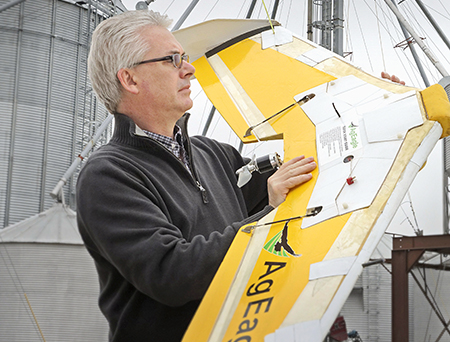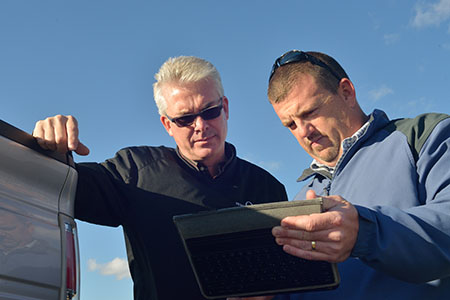This yearlong endeavor looks at how four farmers are evaluating technology and agronomic information that can boost the productivity of their operations.

The start of every new growing season is full of promise. The four farmers participating in the BASF Innovations In The Field program are planning for the upcoming season by evaluating various agronomic and management practices they believe will help take their operations to a higher level of performance. Here's a look at some of the ideas and practices two of the farmers plan to implement.
Most folks look for the arrival of robins as the first sign of spring, but at Cubbage Farms, it's a different bird that marks the season. In late February or early March, Steve Cubbage will launch an AgEagle UAV to get a raptor's view of his wheat crop as it breaks dormancy.
"We want to see what is out there," Cubbage says. This 3,500-acre farm near Nevada, Mo., is operated primarily as a 50-50 corn/soybean rotation, but still devotes about 500 acres to wheat followed by double-crop soybeans.
"In 2014, the first crop we flew with our drone was wheat, and we saw that there were a lot of spots that had drowned out," he says. "We had already made our topdress application, but had I known what was out there, I could have written a prescription and not applied any nitrogen to the bare areas of the field. We estimated that we lost the stand on 10% of the acreage, so that would have been a 10% reduction for N-and a significant cost savings."
As it turned out, the 2014 wheat crop beat the 50-bushel-per-acre mark-"not a record crop by any measure, but a surprisingly good crop," Cubbage observes. "We intend to be much more aggressive in 2015, fly the drone and address any nitrogen issues. We may apply a straight rate of topdress, then decide if we need to come back with a supplemental application where we vary the rate in a targeted fashion. We don't want to leave any bushels on the table."
Not leaving any bushels on the table is a common theme for Cubbage Farms for 2015. "With the price forecast for corn, we are looking closely at every input," Cubbage says. "We've watched fuel prices head lower, and we hope nitrogen costs follow the same trend. Normally, we would have applied some nitrogen in the fall, but we're holding off until spring to apply."
It may be tough for the farm to match its corn yields from last year. "I hope I have a 2015 like 2014, because we were waiting for that kind of a year for a long time," he says. "This was hands down our best corn crop ever. Our farm average, weighed across the scale, was 196 bushels per acre. For southwest Missouri, that is like winning the Super Bowl."
Collecting and evaluating data is second nature at Cubbage Farms. Steve represents the fourth generation on this family farm, and his father, Robert, still helps in the operation. Steve also operates a precision agriculture business called Record Harvest, and two employees from that company, Justin Ogle and Brad Majors, have joined the farming venture.
Discussions about the tight margins in corn have led the management team at Cubbage Farms to consider growing non-traited corn on part of its acres in 2015. The farm had previous experience growing high-value products such as popcorn and Natto soybeans, and still has infrastructure in place to segregate specific bushels.
"We think it [non-traited corn] has potential as a niche market," Cubbage says. "We're looking at planting a couple of hundred acres, and seeing where it takes us."
Corn planters roll early in southwest Missouri. "If field conditions are right, and we are getting the green light from the weather forecast, we go to the field starting March 23," Cubbage says. Hot summers, along with the area's thin claypan soils, place a premium on early pollination.

Hellwig first met with the Cubbage team in 2013. He began to work-up plans for helping the farm effectively terminate its cover crops ahead of soybean planting, while also establishing a herbicide program that provides multiple sites of action against waterhemp.
"Their soybeans are primarily in 30-inch rows, which presents a challenge," Hellwig says. "Since we knew we were facing resistant waterhemp in wide-row soybeans, we wanted to be aggressive. I have always felt that the best strategy is to prevent a problem, not try to cure the problem after it happens."
Hellwig began by setting up two research sites, with 10 plots for soybeans as well as 10 corn plots, looking at various cover crop termination plans plus residual herbicide combinations.
Since Cubbage Farms relies on no-till or minimum-till practices, Hellwig set up a soybean program that included a burndown combination using glyphosate, Verdict and Zidua; that was followed by an in-season application of glyphosate and Outlook. "That provides burndown with a good foundation residual program in a two-layer approach preventing waterhemp," Hellwig says. "We learned how to effectively apply the right products in the right order, and that's the program Cubbage Farms plans to follow for 2015."